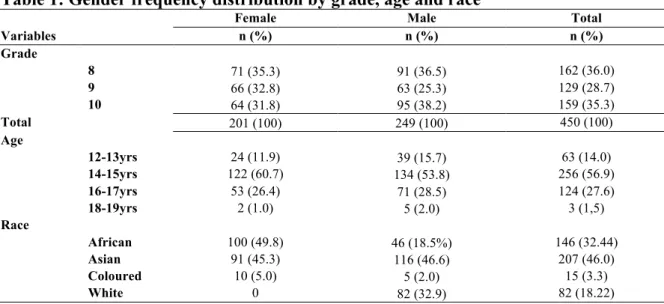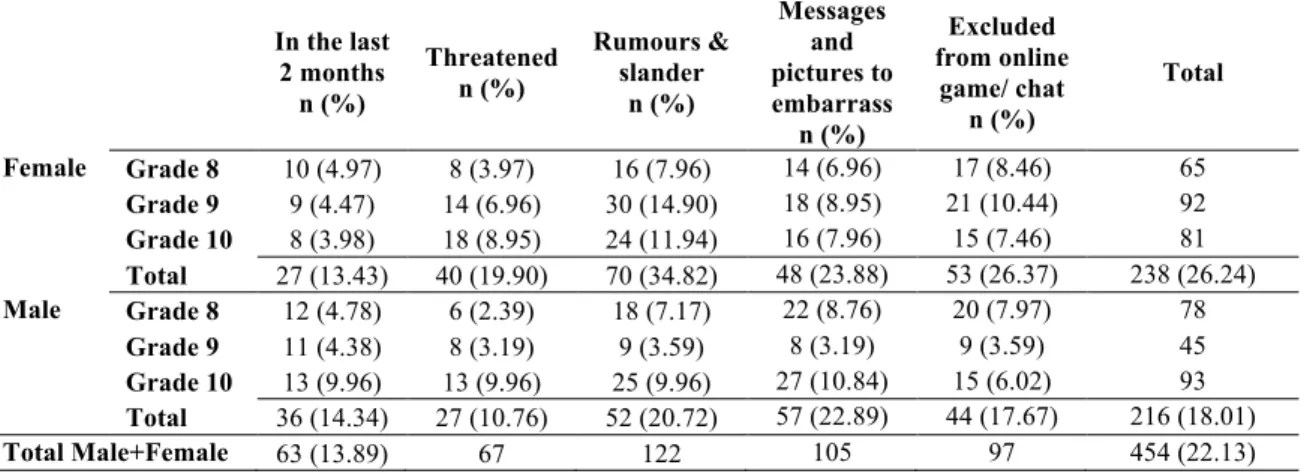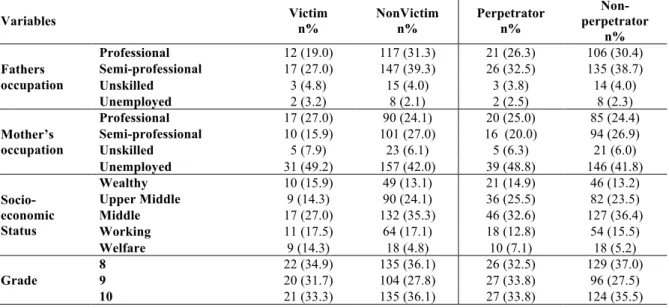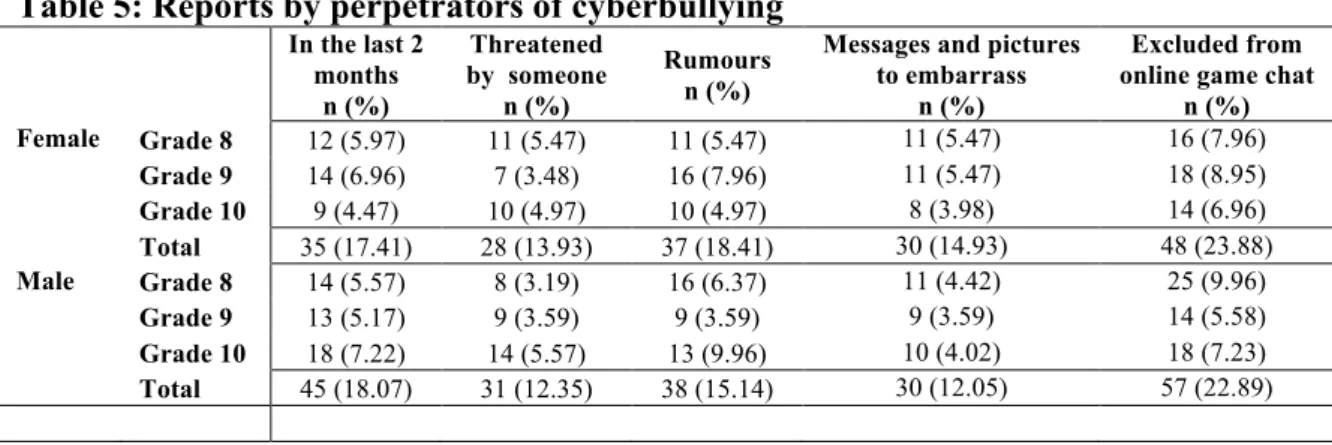INTRODUCTION
Statement of the problem
What is the relationship between the perpetrators and victims of cyberbullying in terms of age, gender, urban-rural dichotomy and socio-economic status. What are the behavioral characteristics and psychosocial factors that are operational among perpetrators and victims of cyberbullying in KZN.
Aims of the study
Sometimes the motivation may be anger, frustration, revenge, asserting social power, or "feeding" the ego of the perpetrator (Sutton, 2011). This study did not include an impact factor score for different forms of cyberbullying. k) This study did not include an impact factor estimate for different forms of cyberbullying.
Hypothesis
Definition of terms
- Bullying
- Cyberbullying
- Psychosocial
Value of the study
This research will provide the necessary government departments with important data for developing the relevant policy and management program to address this important area. In addition, it will provide important empirical data to support and boost future research.
Plan of study
- Chapter One
- Chapter Two
- Chapter Three
- Chapter Four
- Chapter Five
The hypotheses of the study are tested, and based on the results, important conclusions are drawn and discussed. This chapter presents the recommendations, limitations of the study, and suggestions for further research.
Conclusion
Introduction
Bullying behaviour
- Types of bullying behaviour
- Violence and bullying behaviour
- Proactive and Reactive Aggression
- Direct and Indirect Bullying
They further describe bullying as a form of abuse that focuses on the systematic abuse of perceived power. In contrast, reactive aggression is directed at the victim as a result of an aversive event that causes anger and frustration on the part of the abuser.
Behavioural characteristics of bullies and victims
Victims of cyberbullying were asked, "When you told someone, did you feel like that person took your problem seriously?" The results showed that more students identified themselves as victims of cyberbullying on this item than on the previous items. An avenue for future research could address the study and research of this area of concern for victims of cyberbullying. f) The psychological impact on perpetrators is equally important and the current study found that perpetrators of cyberbullying had strong feelings of worthlessness, guilt, sadness, hopelessness and expressed a loss of interest in daily activities.
Psychological adjustment and bullying
Gender differences in bullying behaviour and implication for
Understanding the nature and prevalence of bullying behaviour in
Townsend, Flisher, Chikobvu, Lombard and King (2008) have cited several studies on traditional bullying behavior among South African secondary school students. Blaya (2001) found an 8% prevalence of bullying among schools in deprived areas in England and France while Mooij (1994) cited in Debarbieux (2003) found that 23% of primary school pupils and 6% of pupils of secondary schools in the Netherlands were regularly bullied.
Cyberbullying
- Definition of cyberbullying
- Cyberbullying and access to technological devices
- Challenges and research concerns in cyberbullying
- The nature of cyberbullying conventions and the impact on victims 23
- Nature and prevalence of adolescent experiences of cyberbullying 25
- Social validation and cyberbullying
- Online relationships and consequences for psychological well-being
- Online behaviour and adolescence developmental and personal
Part of the process of developing responsibility for actions is for the adolescent to realize that the facelessness of virtual communication does not mean that it is victimless (Bamford, 2004). Such acts, whether in jest or intentional, have serious consequences for the victim's social and psychological well-being.
Online communication and Life Satisfaction
Bamford (2004) recommends that young people should be taught that when they encounter inappropriate content in virtual environments, their response should be the intention to "press the back button and move on". In addition, they must be instructed in effective search strategies and must learn how to quickly leave inappropriate sites, especially sites that have set "traps."
Cyberbullying and psychosocial factors
Davis (2001) argued that psychosocial problems such as depression and loneliness predispose some Internet users to maladaptive cognitions and behaviors that result in negative outcomes. Florell (2011a) found that online victims were typically intense Internet users who created content, took more risks online, involved many friends to feel popular, but they found that these individuals had many psychosocial problems offline. Morahan-Martin and Schumacher (2003) found that problematic Internet users are more likely than non-problematic users to use the Internet to meet new people, to seek emotional support, and to play socially interactive games.
Psychological and behavioural effects of cyberbullying
The explanation is that in most cases it becomes difficult to make an accurate assessment of the intention and meaning behind the words, and this can result in misunderstandings and incorrect assumptions being made and acted upon without verification. The caveat is that these situations in cyberspace can quickly escalate into online hostility. Online harassment has a negative impact on a victim's physical, mental or emotional well-being and constitutes a form of actual violence.
Psychosocial characteristics and behavioural problems in
Mean for item 1, "In most cases, my life is close to ideal"; Item 2, "The conditions of my life are excellent.";. This study found that out of the total sample population, they reported being victims or perpetrators of cyberbullying. Lines (2007) reported that name-calling and putting in a bad mood was the most common form of cyberbullying reported in the Kids Help Phone survey, and that 76%. respondents in her study revealed that this form of cyberbullying was used against them.
Differences in the relationship between traditional bullying and
The emergence of cyberbullying in South African schools
An electronic gossip magazine reported that Internet access in South Africa will double in the next five years (The Good News Reporter, 2009). In response, former MEC for Education in the Western Cape, Cameron Dugmore, praised schools that had taken steps to curb this phenomenon. This phenomenon had cropped up not only in schools in the Western Cape, but also in schools in other provinces, where students beat each other up and used their mobile phones to make video clips of the incident. This video clip was sent by message and distributed to other students at the school (Limbada, 2007).
Conclusion
The results in terms of the relationship between age, gender, urban-rural dichotomy and socio-economic status of cyberbullying victims and perpetrators are discussed. Compared to the other groups, perpetrators of cyberbullying did not receive the lowest rating for any behavioral characteristic (see Figure 1). Compared to the other groups, perpetrators of cyberbullying do not receive a low assessment on any behavioral characteristic.
METHODOLOGY AND THE RESEARCH DESIGN
Research design
- Sample
- Review of sample used in the study
The merit of the design is that the researcher uses both quantitative and qualitative research methods to investigate the hypothesis in the most accurate and economical way. The schools selected to participate in the study came from both rural and urban areas. It is important to review the sample used in this study to understand the dynamics of the actual population from which the results were generated.
Instruments and test measures
- Cyberbullying questionnaire
- Self-report questionnaires on psychosocial factors
- Data Analysis
- Quantitative Analysis
- Qualitative Analysis
Bar-On's Emotional Quotient Inventory (EQ-I) was therefore used to measure participants' psychological well-being. The data were analyzed using the 19th edition of the IBM Statistical Package for the Social Sciences (SPSS 19). The data will be analyzed using the 19th edition of the IBM Statistical Package for the Social Sciences (SPSS 19).
Reliability and validity of the instruments
The t-test will be used to determine if there is a significant relationship between the variables of interest. Two questions in the cyberbullying questionnaire are open-ended and form part of the qualitative data. Visser (2003) investigated the adequacy of the measure by score analysis of the questionnaire and concluded that it was appropriate for South African adolescents of different racial groups.
Procedure
The researcher handed over the questionnaires and read out the introduction and background information about the study. The researcher found that discipline, supervision and control of the school population was of a high standard in all four schools. In one of the co-educational schools, a certain group from group 10 was initially not focused or attentive, but came into its own as the discussion progressed and remained so until the end of the research session.
Conclusion
The learners (both male and female) chose to disclose to their friends that they were victims of cyberbullying. The present study did not include a score for the impact factor in the different forms of cyberbullying. Perpetrators of cyberbullying were in more trouble at school compared to non-perpetrators, victims and non-victims.
RESULTS AND DISCUSSION
Characteristics of the sample
Social networking (62.2%) was the preferred form of electronic communication among men, followed by instant messaging (56.2%). Among women, the most popular method of electronic communication was instant messaging (53.7%) - via mobile phone or the Internet, followed by chat rooms (37.3%). The least preferred form of electronic communication shared by both male and female groups was email.

Findings and discussion
- Quantitative findings
- Cyberbullying and well-being
- Victims of cyberbullying
- Perpetrators of cyberbullying
The victims of cyberbullying had the lowest percentage score for “Yes” and the highest percentage score for “No” compared to. Among the groups, perpetrators of cyberbullying had the highest score for "Yes" and the lowest score for "No". Perpetrators of cyberbullying had the second highest score (23.8%) compared to the other groups who have difficulty learning to read.

Qualitative findings
- Victims’ descriptions
- Perpetrators descriptions
None of the victims gave a brief description of what happened, but simply responded in monosyllables using the form of cyberbullying they were subjected to. The types of cyberbullying they described inflicting on victims included: profanity and abuse (2.49%); slander and rumors (0.47%) and harassment (0.99%). Again, responses were monosyllabic and participants indicated only the type of cyberbullying they inflicted on the victim.
Discussion
- Prevalence
- Forms and conventions of cyberbullying
- Age, sex, Socio-economic status and urban/rural dichotomy
- Mode/Method to transmit cyberbullying
- Persons’ who inflict cyberbullying
- Disclosure of cyberbullying of victim
- Support and help for victims
- Life Satisfaction and cyberbullying
- Psychological well-being and cyberbullying
- Victims of cyberbullying
- Perpetrators of Cyberbullying
- Behavioural and Social factors
- Conclusion
According to the results of this study, the most used form of cyberbullying was instant messaging, which was reported by more than half of the perpetrators. Results comparing victims, non-victims, perpetrators and non-perpetrators of cyberbullying on the LSS total score indicated that cyberbullying victims scored lower than non-victims on the LSS. The results of the social experiences of victims and non-victims and perpetrators and non-perpetrators of cyberbullying showed that three-quarters of students responded that they liked school and their teachers.
RECOMMENDATIONS, LIMITATIONS AND AVENUES FOR
Recommendations
- Adolescent help-seeking behaviour
- Link between Department of Health and Education
- Creating a school environment conducive to helping victims
- Equipping school personnel
- School code of conduct
- Support networks
- Online Sites
- Parental Responsibilities
- Internet Service Providers
- Cybercrimes
- Protection of Harassment Bill
- Law Enforcements
- Positive Outcomes
As for the school's code of conduct, a section may need to be devoted to the school's policy. It is recommended that in addition to schools developing an infrastructure to deal with cyberbullying, other support networks outside the school context should also be expanded and established. It is recommended that schools familiarize students and parents with the Anti-Harassment Bill so that they are aware of the law when engaging in online practices.
Limitations of the Study
Retrieved from http://www.streetnewsservice.org/news/2011/march/feed-271/online-bullies-to-face-the-music-for-harassment.aspx. Retrieved from http://www.itnewsafrica.com/2008/11/mobile-internet-users-soar-to-15-million-in-south-africa/. Understanding Poverty and Development from http://www.etu.org.za/toolbox/docs/development/poverty.html.
Avenues for future research
Conclusion
The information will be used to help improve learner and educator knowledge which will have positive outcomes for scholastic performance of learners and in promoting the psychological well-being of learners. Participation in the study is voluntary and your child is not expected to answer any of the survey questions with which he/she is uncomfortable. Paper presented at the XX111 World Congress of the International Association for Suicide Prevention Conference, Durban, South Africa.







